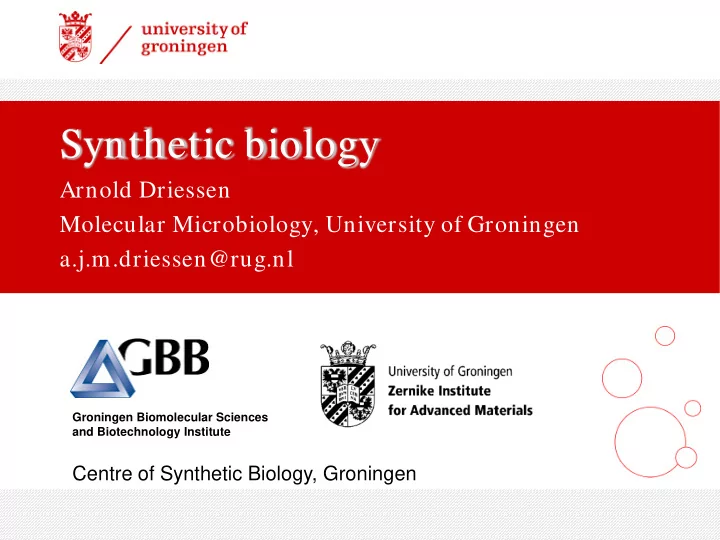

Synthetic biology Arnold Driessen Molecular Microbiology, University of Groningen a.j.m.driessen@rug.nl Groningen Biomolecular Sciences and Biotechnology Institute Centre of Synthetic Biology, Groningen
Definition Synthetic Biology Design and construction of new biological parts, devices and systems, and the re-design of excising natural biological systems for useful purposes
Synthetic Biology ‘ Let me now comment on the question "what next". Up to now we are working on the descriptive phase of molecular biology. ... But the real challenge will start when we enter the synthetic biology phase of research in our field. We will then devise new control elements and add these new modules to the existing genomes or build up wholly new genomes. This would be a field with the unlimited expansion potential and hardly any limitations to building "new better control circuits" and ..... finally other "synthetic" organisms, like a "new better mouse". ... I am not concerned that we will run out of exciting and novel ideas, ... in the synthetic biology , in general (Szybalski, 1974) ,
Areas of research Creation of new biological systems with a focus on: • Understanding of how does life work ( origin of life ) (protocells, selfreplication, re-build a minimal cell from parts … … ) • Use to benefit society (bio- technology, certain areas of biological and biomedical engineering)
Key enabling technologies • Genetic engineering: • Increased speed/ lower costs of DNA sequencing and synthesis • Use modular principles – building blocks, standardization (Biobricks) • Use to: • Build new biological systems • Rewriting, re-building of natural systems
De nov o DNA synthesis Synthetic biology requires rapid & reliable & cheap methods for de novo DNA synthesis and assembly of DNA fragments Tim eline : 2000: 9.6 kbp Hepatitis C virus genome (60-to 80-mers) 2002: 7.7 kbp Polivirus genome 2003: 5.4 kbp bacteriophage Phi X 174 (in 2 weeks) 2006: Synthetic genome of Mycoplasm a genitalium (laboratorium ) 2010: Introduction of synthetic genome of M. m ycoides into M. capricolum (acclaimed synthetic cell) 2012: Church’s Book (5.3 Mb) encoded in DNA Greg Venter
Biobricks Standard of interchangable genetic parts • Parts – a finite DNA sequence with a specific function (promoters, coding genes, terminators, ribosome binding sites) • Devices – multiple parts with a higher level of functioning (translational units, riboregulators, reporters, inverters, sensors etc) • System s – multiple devices hooked up together by Drew Andy
Im pact of synthetic biology on research • Synthetic genomes – rewire cells • Synthetic operons – re-arrange gene order / introduce new genes / ease transfer to heterologous hosts • Refactoring: codon racemise to remove regulatory sequences; re-order genes in operon; screen • Design novel enzymes that specify new catalytic activities or other functionalities
Exam ples of synthetic biology Designer ‘bugs, • Biosensors – bacteria that sense pollutants, cancer, artificial nose, etc ( critters-on-a-chip ) • Hydrogen from water with cyanobacteria • Biofuels and base chemicals biosynthesis from renewable feedstocks • Biosynthesis of medicines (f.i. artemisinin) • Nitrogen fixation by non-fixing plants • Expand sugar crops by plants • Increase seasonable tolerance of plants/ trees
What are we doing? • Biosynthetic route towards the fermentative production of caprolactam: building block nylon 6 • Rewiring the Bacterial ester-based phospholipid bio- synthetic pathway of Escherichia coli for Archaeal ether- lipids (create an archaeabacterium ) (evolutionary studies) Ether lipids Ester lipids
Protocells Bottom-up approach to explore path between living and nonliving systems ( Origin of Life / Evolution ) Reproduce protein, lipid, DNA and RNA synthesis and division from a synthetic genome encapsulated in a liposome or droplet
mm-dd-yy | 12
Sy nthetic biology to benefit society
Recommend
More recommend